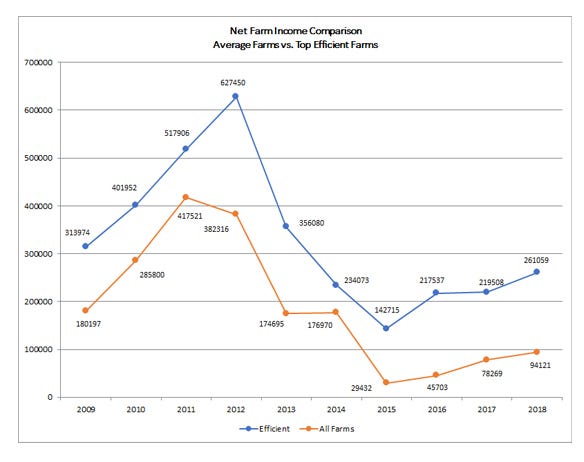
What sets an efficient farm apart from the average farm? In a lot of cases, it may simply be doing many things a little better.
Nebraska Farm Business Inc. recently unveiled its data for its "Top Efficient Farms" group of 2018, showing a comparison between the most efficient farms and the average of all the farms working with Nebraska Farm Business Inc.
In 2018, the net farm income average of all farms was $94,121. That may be a surprisingly high number, but when compared with the net income of $261,059 for the Top Efficient Farms, there is a significant difference.
Tina Barrett, Nebraska Farm Business Inc. executive director, explains the Top Efficient Farms group is a selection of operations that consistently retain more than 20% of gross income as net. These farms are not necessarily the highest efficiency farms each year but are the most consistent from year to year. And knowing certain farms are more efficient doesn't tell the story of how it's done.
"I wish I had a list of 10 steps on how to be more efficient, but it's not quite that easy to pinpoint," Barrett says. "It's not marketing, it's not yields, and it's not even saving on major inputs. It's not saving on seed, inputs and chemicals. It's saving a little bit in every category."
The data doesn't show one single category of expenses that make up the difference alone. However, most categories show a $1 to $5 difference per acre. In total, the difference between the Top Efficient Farms group and the average of all farms amounts to $40 to $60 per acre.
"It might be a difference of saving $2 to $3 per acre on seed; fertilizer costs go back and forth with no consistency; and there was a little savings in chemical costs between the two groups — less than $5 per acre," Barrett adds. "When we add up those dollars per acre and add in savings on equipment, fuel costs, utilities and everything down the line, it seems the biggest difference is day-to-day discipline on controlling every cost. It's not letting things go that are $2 to $3 an acre because they don't amount to much. When you make 20 to 30 of those decisions, they make a difference."

TOP FARMS: Net farm incomes for the average of all farms in the Nebraska Farm Business Inc. group, and the "Top Efficient Farms" group from 2009 to 2018. (Source: Nebraska Farm Business Inc.)

In 2018, the Top Efficient Farms averaged a higher yield — about 5 bushels per acre higher in corn production — than the average of the Nebraska Farm Business Inc. group. It's not always the case, although data from five of the past 10 years show a 5-plus-bushel-per-acre advantage for the Top Efficient group.
It's worth pointing out that between the two groups, the difference between average marketing price received for both corn and soybeans over the past 10 years was barely noticeable.
"It's hard to know for certain, because we're averaging two groups of people," Barrett says. "Some may be marketing better, and some aren't but are still making a healthy profit. Every farmer finds their own way of making things work. If you can market a little better, spend a little less on inputs and produce a little more in yield, it's going to add up even faster."
It's also worth noting that both groups in this study have comparable gross farm incomes. In 2018, the average gross farm income of the two groups was within $50,000. So, the size of the operation does not make a difference in overall profitability.
"I think a lot of people think that bigger farms make more money, but I think, if anything, this has shown you can be smaller if you can retain a higher percentage of your gross farm income," Barrett says. "If everything were equal, if you gross twice as much, you would make twice as much, but our data doesn't show that. It seems to be more about how efficiently you're keeping dollars than how many you're bringing in to begin with."
Barrett emphasizes the takeaway is to make sure the decisions being made produce the highest net return — not necessarily the highest gross return.
"One thing we can see by looking at as many individual farms as we have is there's so much variability out there in terms of size and profitability," she adds. "Especially if you're benchmarking and you're at average or better, it's good to set your sights on another group to see how you can improve your operation."
About the Author(s)
You May Also Like






